FT-IR-Spektrum: Unterschied zwischen den Versionen
K (→Literatur) |
K (→Literatur) |
||
| Zeile 151: | Zeile 151: | ||
|} | |} | ||
=== | === Weitere interessante Artikel === | ||
Berdahl MH, <ref> Berdahl MH, Pollen Analysis by FTIR Spectroscopy - A Feasibility Study for an Automated Method, Master Thesis 2014, Norwegian University of Life Sciences [https://nmbu.brage.unit.no/nmbu-xmlui/bitstream/handle/11250/278095/berdahl_master2014.pdf?sequence=4&isAllowed=y (PDF-File)]</ref>, | Berdahl MH, <ref> Berdahl MH, Pollen Analysis by FTIR Spectroscopy - A Feasibility Study for an Automated Method, Master Thesis 2014, Norwegian University of Life Sciences [https://nmbu.brage.unit.no/nmbu-xmlui/bitstream/handle/11250/278095/berdahl_master2014.pdf?sequence=4&isAllowed=y (PDF-File)]</ref>, | ||
Depciuch J. et al. <ref> Depciuch J. et al, Identification of birch pollen species using FTIR spectroscopy, Aerobiologia (2018), 34, 4, p. 525-538 [https://link.springer.com/article/10.1007/s10453-018-9528-4 (Abstract)] </ref>, | Depciuch J. et al. <ref> Depciuch J. et al, Identification of birch pollen species using FTIR spectroscopy, Aerobiologia (2018), 34, 4, p. 525-538 [https://link.springer.com/article/10.1007/s10453-018-9528-4 (Abstract)] </ref>, | ||
Kasprzyk I. et al. <ref>Kasprzyk I. et al., FTIR-ATR spectroscopy of pollen and honey as a tool for unifloral honey authentication. The case study of rape honey, Food Control (2018), 84, p. 33-40 [https://www.sciencedirect.com/science/article/pii/S0956713517303626 (PDF-File)]</ref>, | Kasprzyk I. et al. <ref>Kasprzyk I. et al., FTIR-ATR spectroscopy of pollen and honey as a tool for unifloral honey authentication. The case study of rape honey, Food Control (2018), 84, p. 33-40 [https://www.sciencedirect.com/science/article/pii/S0956713517303626 (PDF-File)]</ref>, | ||
Buta E. et al., <ref>Buta E. et al., FT-IR Characterization of Pollen Biochemistry, Viability, and Germination Capacity in Saintpaulia H. Wendl. Genotypes, J. Spectrosc. (2015), Article ID 706370 [http://downloads.hindawi.com/journals/jspec/2015/706370.pdf (PDF-File)]</ref> | Buta E. et al., <ref>Buta E. et al., FT-IR Characterization of Pollen Biochemistry, Viability, and Germination Capacity in Saintpaulia H. Wendl. Genotypes, J. Spectrosc. (2015), Article ID 706370 [http://downloads.hindawi.com/journals/jspec/2015/706370.pdf (PDF-File)]</ref> | ||
=== Literatur === | |||
<references /> | <references /> | ||
{{Zitieren}} | {{Zitieren}} | ||
Version vom 10. Oktober 2019, 09:43 Uhr
FTIR bzw. Fourier-Transformations-Infrarotspektrometrie
Rohspektren[Bearbeiten]
Die Spektren sind als erste Versuche anzusehen.
Unbehandelte Pollenproben. Aufgenommen mit einem Bruker FT-IR Spektrometer Alpha P, 24 Scans pro Spektrum, Wellenzahl 300 bis 4000 cm-1.
| FT-IR Spektrum | Wellenzahl (cm-1) Absorbance Units |
|---|---|
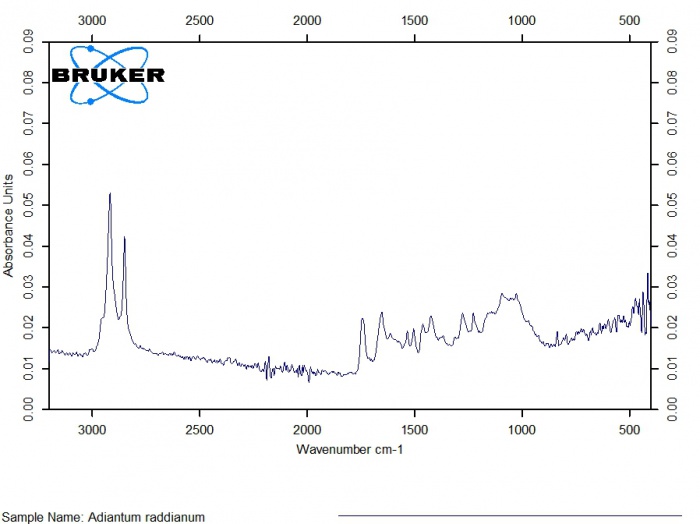
|
Adiantum raddianum
2920, 0.053 |
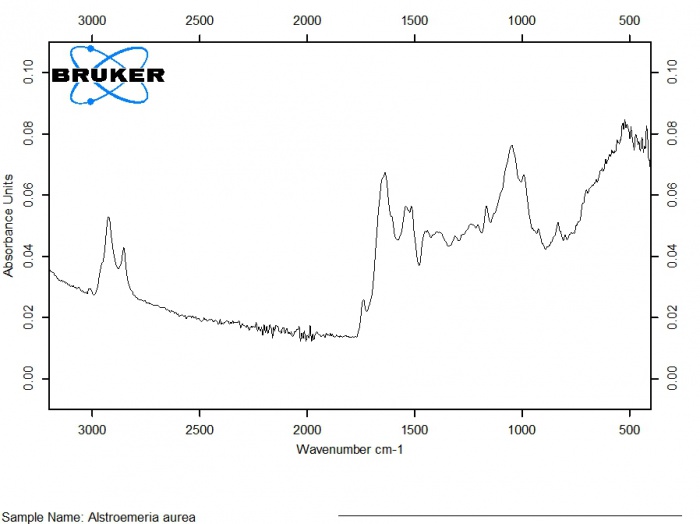
|
Alstroemeria aurea
2920, 0.053 |
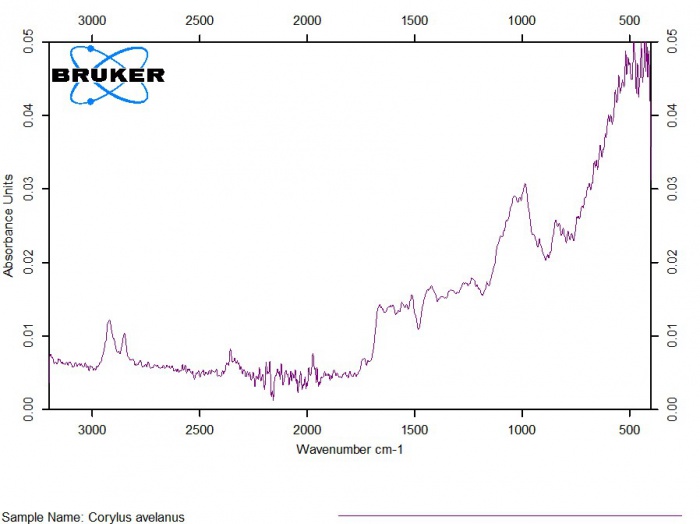
|
Corylus avellana
2915, 0.012 |

|
Hippeastrum aulicum
2920, 0.038 |
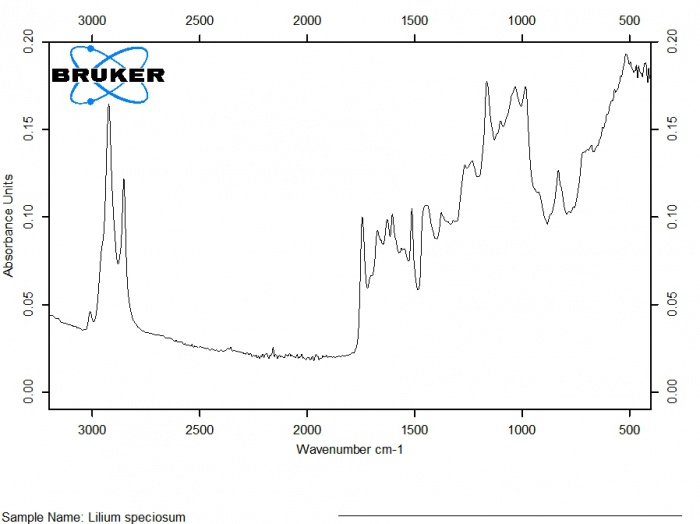
|
Lilium speciosum
2920 |
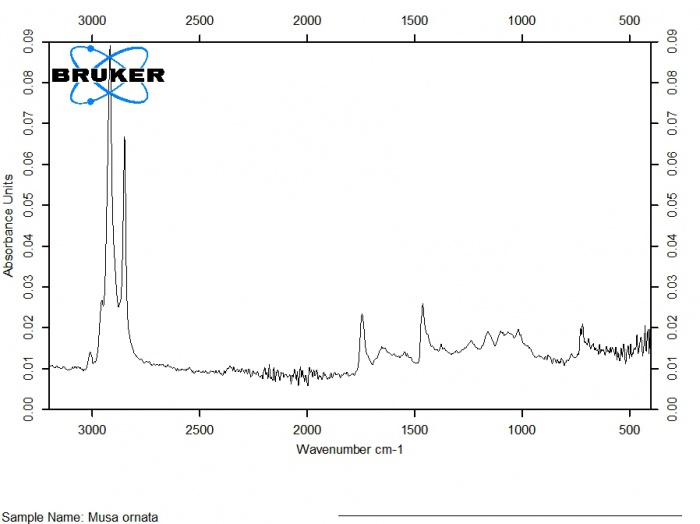
|
Musa ornata
2920 |
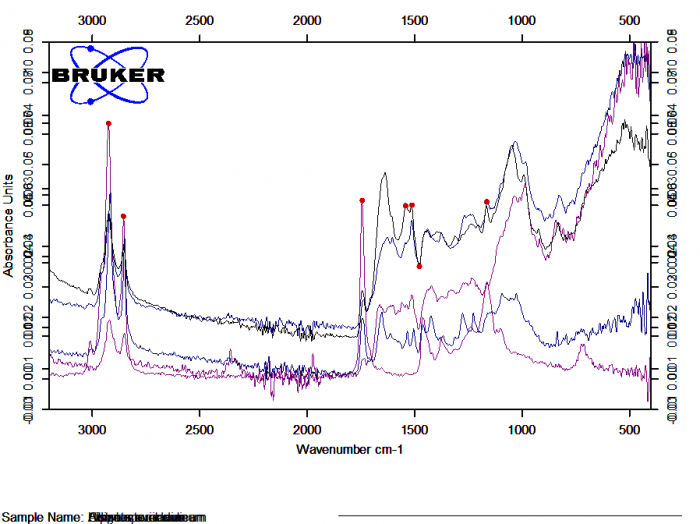
|
All in one
2920, Kohlenhydrate C-H |
Wichtige Peaks[Bearbeiten]
| Wellenzahl (cm_1) | [1][2][3] |
|---|---|
| 2920 | C-H stretching |
| 2850 | CH (Methoxy..) stretching |
| 1745 | C=O stretching |
| 1650-60 | Amide I |
| 1605 | Sporopollenin |
| 1550 | Amide II und Lignin |
| 1515 | Sporopollenin |
| 1462 | C=O stretching |
| 1410-1460 | Lipide und Proteine |
| 1171 | Sporopollenin |
| 970-1700 | Kohlenhydrate |
| 833 | Sporopollenin |
Weitere interessante Artikel[Bearbeiten]
Berdahl MH, [4], Depciuch J. et al. [5], Kasprzyk I. et al. [6], Buta E. et al., [7]
Literatur[Bearbeiten]
- ↑ Zimmermann B, Kohler A, Infrared Spectroscopy of Pollen Identifies Plant Species and Genus as Well as Environmental Conditions. PLoS ONE (2014): 9(4): e95417. doi:10.1371/journal.pone.0095417 [1]
- ↑ Dell'Anna R et al, Pollen discrimination and classification by Fourier transform infrared (FT-IR) microspectroscopy and machine learning, Anal Bioanal Chem (2009): Jul 394(5):1443-52. doi: 10.1007/s00216-009-2794-9. Epub 2009 Apr 25 [2]
- ↑ Ofelia A et al, Pollen composition discrimination by FTIR-ATR Spectroscopy, Conference Paper, Annual meeting of the International Honey Commission, OC5, Braganca, Portugal, September 2012 [3]
- ↑ Berdahl MH, Pollen Analysis by FTIR Spectroscopy - A Feasibility Study for an Automated Method, Master Thesis 2014, Norwegian University of Life Sciences (PDF-File)
- ↑ Depciuch J. et al, Identification of birch pollen species using FTIR spectroscopy, Aerobiologia (2018), 34, 4, p. 525-538 (Abstract)
- ↑ Kasprzyk I. et al., FTIR-ATR spectroscopy of pollen and honey as a tool for unifloral honey authentication. The case study of rape honey, Food Control (2018), 84, p. 33-40 (PDF-File)
- ↑ Buta E. et al., FT-IR Characterization of Pollen Biochemistry, Viability, and Germination Capacity in Saintpaulia H. Wendl. Genotypes, J. Spectrosc. (2015), Article ID 706370 (PDF-File)
Stebler Th., FT-IR-Spektrum, In: Pollen-Wiki (03. Apr. 2025), https://pollen.tstebler.ch/MediaWiki/index.php?title=FT-IR-Spektrum .